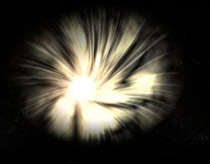The tragic fate of the first generation of stars
The first stars in the universe used to contain millions of microscopic black holes. Over time, small black holes joined together to form a large black hole and devour the star from within.

A star is sucked into a black hole.Photo: Newscientist.
The origin of the supermassive black hole in the center of the galaxies is still a mystery without an answer. Some astronomers have speculated that, in the early stages of the universe after the big bang, dust and radioactivity dominated the space. Tiny black holes may have formed in those dust and radioactivity.
Recently Cosimo Bambi, a Tokyo University physicist and colleagues demonstrated that microscopic black holes destroyed the first generation of the universe by swallowing them. After that, black holes continued to swell and hide in the center of the galaxies.
The team estimated that the first stars were formed about 200 million years after the big bang, in the central area of the densest dust. Ultra-small black holes pull gas dust toward them, enabling the formation of stars.
Cosmico and colleagues wanted to find out what would happen if the microscopic black holes at the early stage of the universe joined together to form larger black holes. They hypothesize that each initial black hole has a mass equal to the asteroid Ceres (the largest asteroid in the solar system, moving on the meteorite belt between Mars and Jupiter).
Previous observations have shown that black holes heavier than Ceres have never existed. But if there is less mass than Ceres, black holes will quickly evaporate due to the effects of quantum effects. A star formed at the center of a black hole group can hold up to a million microscopic black holes along with ordinary matter. The dense density of matter causes black holes to settle down to the star's core and join together, creating a giant black hole.
After that, the giant black hole began sucking up the star's matter from within and completed the destruction process in less than a million years to achieve a mass of 10 to 1,000 times the Sun. Once that size is achieved, the black hole continues to swell at a greater speed than before by sucking in the surrounding dust. They eventually turned into 'super black holes' in the center of galaxies, with masses of billions of times that of the Sun.
So why does the same thing not happen in the modern universe? According to the team, the biggest difference lies in the fact that most stars today form outside the center of galaxies, where there are very few primitive black holes. As a result, new stars rarely suffer the tragic fate of the first generation of stars.
'That's why primitive black holes can't swallow the whole star in our galaxy , ' explains Katherine Freese, an astronomer at the University of Michigan.
- The fate of the universe is written on stars
- FATE - An early warning device for the elderly
- Coincidence or fate arranged
- 28 mysterious remains reveal the disaster from the game of children
- Constellations 13 billion years old
- The formation of young star generations
- 9 interesting things about stars
- Discovering the 'culprit' caused the comet to crash into Earth
- The tragic fate of Earth's
- 7 most tragic events in human history
- Hypothesis of the fate of the Earth if the universe exists 2 Sun.
- Explain the mystery of missing stars in the universe
 Van Allen's belt and evidence that the Apollo 11 mission to the Moon was myth
Van Allen's belt and evidence that the Apollo 11 mission to the Moon was myth The levels of civilization in the universe (Kardashev scale)
The levels of civilization in the universe (Kardashev scale) Today Mars, the sun and the Earth are aligned
Today Mars, the sun and the Earth are aligned The Amazon owner announced a secret plan to build a space base for thousands of people
The Amazon owner announced a secret plan to build a space base for thousands of people